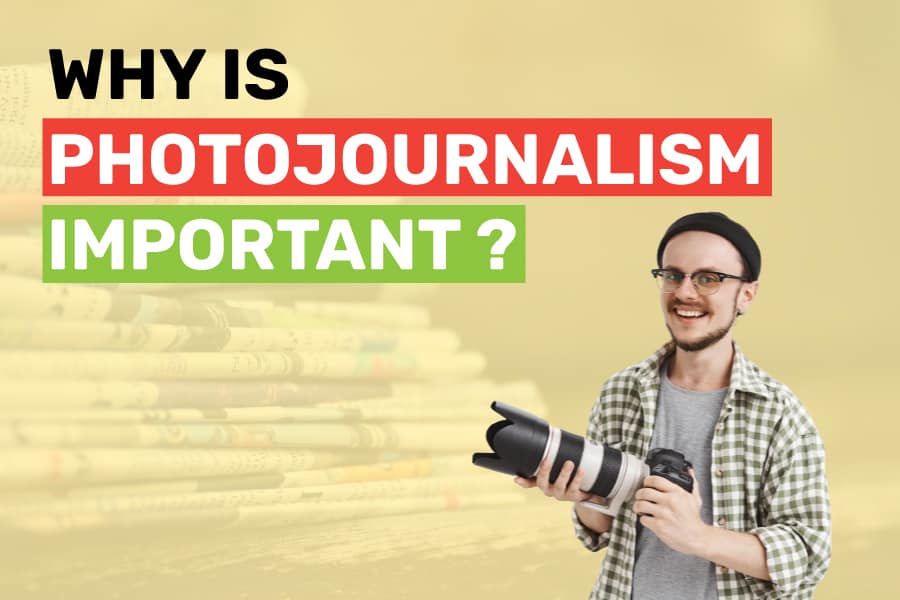Are you a photojournalist, or would you like to be one? Why is photojournalism important in the media world today?
Now, imagine a media house publishing a story without adding photos. Such a story would be boring. In addition, readers will struggle to comprehend or even remember the entire story, report or news.
Here, we’ll discuss why photojournalism is vital and other must-know information about photojournalism. So, keep reading if you want to know more!
Why Is Photojournalism Important
Photojournalism is important because it adds further context to newspaper stories, reports, articles, and stories. The photos photojournalists capture give more depth to stories and make them more tangible.
Photos can convey information in a more precise and easy-to-understand manner. They are easier to comprehend and make stories more comprehensive.
Is Photo Editing Important In Photojournalism?
The quality of photos used in your photojournalism work greatly matters. It will impact how people would perceive your work.
So, if you’re a photojournalist or an aspiring photojournalist, having sound photo editing skills is helpful. But if you don’t have such skills, that shouldn’t stop you from pursuing a career in photojournalism.
Photo editing skills can be helpful to a photojournalist. Why? You will be doing a lot of editing work occasionally.
The easiest way most photojournalists edit their photos to enhance their quality and appeal is to outsource to a reputable agency. Find an affordable photo editing agency to edit and enhance your photos regularly.
When you outsource your work, you’ll have time to pursue more stories and focus on capturing more photos. You’ll be able to accomplish much within a short time, rest properly and have time for the lovely people in your life.
Another good thing about outsourcing a photo editing project is the assurance that the output will be top-notch. You’ll have well-edited photos that top magazines, newspaper publishers, schools, website owners, and brands would be proud to publish on their platforms.
Now, who should you outsource to? Remember to find an affordable, reputable and dedicated photo editing agency for your editing tasks. And negotiate with them to get the best deal for long-term collaboration.
Designyep is an online photo editing agency with years of experience in the niche. You can contact them for your photo editing needs. They are ready to go into a long-term partnership with photojournalists, photographers, brands, manufacturers, and anyone who needs high-quality photo edits consistently.
What Does Photojournalism Mean?
We started this content by mentioning the importance of photojournalism. Now, let’s define the term: What is photojournalism?
Photojournalism is another form of journalism that involves capturing photos of critical scenes, events, and activities. It entails using photographs to tell a story.
In photojournalism, the main focus is the photographs. Texts are only used to write captions and include some details about the photo.
Photojournalists let their photos do the talking, making them different from conventional journalists.
The difference between a photojournalist and a conventional photographer can be deduced from the nature of their work. The similarity is that both professionals aim to tell their stories to warn, inform, educate and entertain.
Photojournalism Vs Journalism: What Are The Differences?
Photojournalists convey their stories via images. They can use pictures to deliver their point in the story, and people will understand.
So, a photojournalist only needs a good camera and a newsworthy event to work. There’s no need for a pen or paper. However, a photojournalist would need a computer to sort the photos captured or include captions.
Another thing a photojournalist would need a desktop for is to edit the photos and send them to the publishers or include them in their stories. However, even if you don’t have photo editing skills, there’s no need to get worried. You can outsource your work.
Now, let’s discuss a little about conventional journalists. How do they differ from photojournalists?
Conventional journalists write their stories using pen and paper (or a computer system). Most of them may capture images from scenes with their phones or cameras and include them in their stories .
These types of journalists don’t use photos to convey their entire story. They may use a couple of original images captured on the scene or select stock photos related to the scene. Conventional journalists bother more about the quality of the write-up than the information conveyed by the photos used.
So, while a photojournalist would care more about the quality, and information the photos captured are conveying, the conventional journalist would be more worried about grammar errors, or the quality of the write-ups.
In summary, photojournalists need more photos to convey their stories, while conventional journalists need more information to write their stories.
Have you been to any crime scene or event with photojournalists present? They are always the first to appear in such scenes before the conventional journalists arrive.
A Handy Tip: As a photojournalist, you must be proactive. You must arrive at scenes of events or crimes to capture a good quality shot before most of the evidence and picture-worthy objects or evidence are removed from the event scene.
A traditional journalist can rely on witness testimony to write their stories, but a photojournalist would need authentic photos, not mere verbal descriptions of what transpired.
A Short History of Photo
The history of photojournalism is an exciting read. We will make it easy to grasp by delivering the different events that transpired via bullet points.
- Photojournalism merged in the mid-19th century. It emerged alongside photography.
- Photojournalism grew massively around the late 19th and early 20th century. The reason for this growth was the technological advancements at the time. The emergence of printing technology also facilitated its growth.
- Mathew Brady, Lewis Hine and Robert Capa are prominent figures who gave photojournalism a face. Brady, Hine and Capa, during the Civil War, early 20th century and World War II, respectively, captured memorable scenes and social issues. They showed how powerful photojournalism can be.
- Magnum Photos’ establishment was in 1947. The agency, a renowned photo agency, expanded its reach to photojournalism.
- Photojournalists are making a significant impact worldwide, and we have them to thank for their outstanding work. We cannot forget their exceptional work during the COVID-19 pandemic, capturing essential moments in the lives of patients, their families and healthcare providers.
Photojournalists document global events using digital and traditional platforms. They help us to preserve history and raise awareness most convincingly.
What Are The Impacts of Photojournalism?
Photojournalism has become even more popular thanks to the rise of the internet, mobile devices and digital photography. It has become more popular than it has ever been.
Through photojournalism, people worldwide have been able to see firsthand the devastation wars bring to a nation, its people and its military.
Photos are compelling. They captivate and stick in our memories longer than words or plain texts. Seeing the devastation of the 9/11 attack in photos would remind the coming generation of why the United States government acts the way it does towards organizations fighting against the peace and stability of other countries.
For Ukrainians, all citizens have are images of their beautiful homes and cities. Today, they have all been reduced to rubles. And pictures of the rubles remind them about the brutality of the war.
In summary, below is the impact photojournalism can have on a story and people.
- It evokes an emotional element in stories, especially breaking news stories.
- It makes journalism more inclusive, as it features diverse locations and demographics.
- It enhances the act of storytelling.
- It makes stories more engaging and worthwhile. Incorporating quality photos in a boring story can change the dimension of that story.
The Best Camera For Photojournalism That You Should Consider
There’s no point naming a specific camera as the best for photojournalism. If you can capture good-quality photos with your current phone or camera, it’s good enough for photojournalism.
No rule says a photojournalist must purchase or carry a camera that costs a fortune. The quality of the image is what counts the most.
Most photojournalists even rely on their mobile phones to take quality pictures. This allows them to capture various events and scenes that took place impromptu, as mobile devices are flexible, accessible, and easy to move around.
So, what determines a good-quality photo? The resolution does. Others include the distortions perpetrated by the lens, like chromatic aberration and appropriate focal length usage.
As a photojournalist, you have a role to play concerning the quality of your photos. Get the timing, composition and message right, and your photos would be valuable to media houses.
Whether you are using the most expensive camera in the world, it would be worthless if you don’t have an eye for detail or lack knowledge of Good composition.
A Handy Tip: Taking good pictures is essential to a photojournalist. But that means learning how to capture images and edit them.
The Different Types of Photojournalism
Photojournalism boasts several branches, but here, we will list the main ones. So, if you’re an upcoming photojournalist, read to understand the different fields in the profession.
1: Sports photojournalism: Photojournalists in this field cover everything about sports. As you know, photojournalists cover important events, so the same happens in sports.
From kids in developing countries playing hockey to the Olympics and other major sporting events in the developed part of the world, sports photojournalists cover everything about sports.
As a sports photojournalist, you don’t need to have a preference for a specific kind of sport. Instead, it would help if you were interested in all the different types of sports.
2: Spot news photojournalism: What does this type of photojournalist entail? A spot news photojournalism covers unplanned events which the public needs to know are happening. Examples of such events could be plane crashes, car accidents, and school lockdowns.
3: General news photojournalism: This is the first category that will come to most people’s minds when asked to mention the different types of photojournalism. But what does it entail?
The general news photojournalism covers hard and breaking news. These include news about current protests, national conferences, and others.
4: Feature photojournalism: This visual journalism category is where viewers get entertained. For example, you might encounter a feature displaying a day in the life of someone special. It could be an actor, actress, comedian, athlete or world-renowned singer.
The field of photojournalism is broad. So, there is plenty to focus on if you’re a beginner. But it is an exciting career, especially if you’re ready to give your all.
Characteristics of Photojournalism That Differentiate It From Regular Photography
Photojournalism has several features or characteristics that show why it differs from typical photography. Here is why.
1: Photographs are genuine:
Photographs don’t lie unless manipulated. And professional photojournalists don’t manipulate their photos; they seek to convey their stories via photos just as they know it.
Trying to manipulate the photos is like destroying evidence, a serious offense. So, photojournalists always try to stay unbiased and deliver the stories as they are.
They’ll show the different sides of a story via photos, regardless of how unpleasant, graphic or difficult the visual content might be.
So, be unbiased and genuine if you’re a photojournalist who wants to leave an indelible mark on your generation. Let the world take cognizance of your sincerity and know you as an unbiased visual journalist.
Give images that show what transpired. Let the viewers see the honesty in your story.
You don’t need to inform them or try to convince them. People are more intelligent than they look. They can spot biases in a story or photo on their own.
2: Photographs must provide detailed information and clues:
Conveying a story via a series of photos without words is easier when the visuals are detailed enough. That’s another thing that differentiates photojournalism from photography.
While the subject’s posture, beauty, and appeal are the primary focus of a photographer or in photography, the photojournalist considers the information photos deliver.
A photo must have detailed information to be valuable in photography. Photojournalists convey their news via photos, not texts. People should be able to deduce valuable clues from each photo a visual journalist captures.
3: Stories must be told promptly:
Every image a photojournalist uses must be timely. But a regular photo doesn’t need to be timely.
The thing about visual journalism is that people want to read the latest news. They want to know what’s happening.
So, visual journalism thrives on telling stories via photos promptly.
The Important Role Photojournalism Plays In News And Newspapers
The photos visual journalists use can either serve as a stand-alone or be used in an article. Whether as stand-alone images or embedded in a newspaper, photojournalists’ visuals help make news more engaging, exciting, memorable and understandable.
Is Writing Important In Photojournalism?
Yes, writing is vital to visual journalism. Photojournalists write less than traditional journalists but usually accompany images with texts.
In other words, captions are crucial in visual journalism. The caption, including the clarity and quality of images, can make or break a story.
How Long Does It Take To Become A Photojournalist?
The number of years varies. However, you should be looking to spend around 4-5 years in school. You can get a degree in visual communication or journalism.
A Handy Tip: Landing a photojournalist job is a breeze for well-trained professionals. You can also announce yourself through independent research and photojournalism work. Get your work to credible news platforms or have a personal blog. However, ensure you’re getting proper credits for your work.
What Are The Duties of Photojournalists?
Photojournalists are professionals trained to capture vital images of events, crimes, and activities that could serve as news.
The events could be sports, festivals, politics, protests, conflicts, etc.
What Skills Are Important In Photojournalism?
You need to have skills as a visual journalist to stand out. Experience is also crucial, but when you have the required skill set, you can easily land a job and gain valuable experience.
So, without further ado, let’s discuss the skills vital to photojournalists.
1: Research skills: You need sound research skills as a photojournalist. You must know how to research events and relate distant stories together. Having excellent research skills will set you apart in the industry.
2: Journalism: You’re a journalist. Let’s forget the “photo” and focus on the “journalist.” As a journalist, you’re expected to strictly follow the code of ethics. Your news must be accurate, unbiased and professional.
3: Photography skills: Your job is to take detailed photos. In other words, your images must be clear and precise and contain information that makes them newsworthy.
As a photojournalist, you must be up-to-date with the latest image-capturing technology, print, and other innovations that make it possible to capture high-quality images.
You must know features in image capturing technology, such as film roll length, autofocus, shutter speed, etc.
4: Photo editing skills: Sound photo editing skills are a good idea. Your images must be top-quality, unique, original, distraction-free and professional.
Editing helps to enhance the quality of an image and removes any distractions. Your photo will appear more professional, attractive, and helpful to media houses.
If you can devote time to developing your photo editing skills, do so. Learn how to use Photoshop and other photo editing software to enhance the appeal of photos.
On the other hand, if you want to devote your entire time to researching and capturing high-quality photos and don’t have the time to spend editing photos, consider outsourcing your photo editing tasks. Find a reputable photo editing agency to help you edit your pictures daily.
You can even negotiate with the agency to give you a reasonable rate since you’ll be using their services for an extended period or possibly your entire photojournalism work. You can find a reputable photo editing agency online.
5: Legal: This isn’t a skill but an essential part of visual journalism. You must understand copyright laws and how to avoid legal issues when capturing or uploading your photos.
6: Interpersonal skills:
As a journalist, having sound interpersonal skills is vital in your profession. How you relate with people will determine if they will be willing to reveal more about an event that happened to you.
Conclusion
So, why is photojournalism important? The images photojournalists capture help to add further context to stories, articles, reports, and news. They also make the news memorable, engaging and rich.
Imagine reading a newspaper without a single image. You’ll feel bored and may even forget some of the information. But with photos, it’s easier to remember stories.
Photojournalists use images to tell stories. They use texts for captions and deliver the rest of the information via photos. They are essential to news platforms, even in this age where social media is changing how news is delivered.



